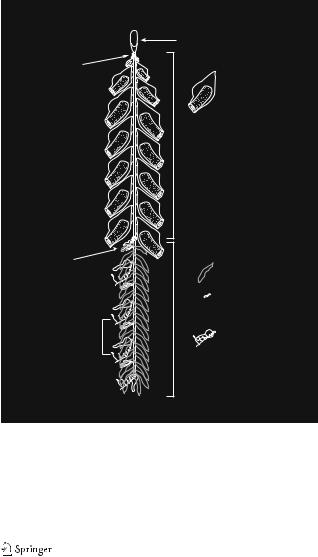
- •Introduction
- •Materials and methods
- •Results
- •A note on terminology
- •Material examined
- •Bathyphysa sibogae
- •Rhizophysa filiformis
- •Rhizophysa eysenhardti
- •Agalma elegans
- •Nanomia bijuga
- •Apolemia sp.
- •Forskalia formosa
- •Lychnagalma utricularia
- •Discussion
- •Siphosomal elements arise independently in the Cystonectae
- •Probud subdivision is a derived, shared mode of development for the Codonophora
- •The developmental underpinnings of organizational diversity in the Codonophora
- •Directional asymmetry of siphonophore colonies
- •Conclusions
- •References

Dev Genes Evol (2006) 216:743–754
DOI 10.1007/s00427-006-0101-8
ORIGINAL ARTICLE
The evolution of colony-level development in the Siphonophora (Cnidaria:Hydrozoa)
Casey W. Dunn & Günter P. Wagner
Received: 17 April 2006 / Accepted: 5 July 2006 / Published online: 16 September 2006
# Springer-Verlag 2006
Abstract Evolutionary developmental biology has focused almost exclusively on multicellular organisms, but there are other relevant levels of biological organization that have remained largely neglected. Animal colonies are made up of multiple physiologically integrated and genetically identical units called zooids that are each homologous to solitary, free-living animals. Siphonophores, a group of pelagic hydrozoans (Cnidaria), have the most complex colony-level organization of all animals. Here the colonylevel development of five siphonophore species, strategically sampled across the siphonophore phylogeny, is described from specimens collected using deep-sea submersibles and by self-contained underwater breathing apparatus diving. These species include three cystonects,
Bathyphysa sibogae, Rhizophysa filiformis, and Rhizophysa eysenhardti, and two “physonects”, Agalma elegans and
Nanomia bijuga. These data, together with previous findings, are analyzed in a phylogenetic framework to reconstruct key features of the history of colony-level organization and development in the Siphonophora. It is shown that gonodendra and gastrozooids of the examined cystonects arise as independent buds directly on the stem, whereas probud subdivision (the origin of feeding, reproductive, and
Communicated by M. Q. Martindale
C. W. Dunn (*)
Kewalo Marine Laboratory, University of Hawaii, 41 Ahui St.,
Honolulu, HI 96813, USA e-mail: cdunn@hawaii.edu
G. P. Wagner
Department Ecology and Evolutionary Biology, Yale University,
P.O. Box 208106,
New Haven, CT 06511, USA
other zooids from a single bud) is a synapomorphy of the Codonophora. The origin of probud subdivision is associated with the origin of cormidia as integrated units of colony organization, and may have allowed for greater morphological and ecological diversification in the Codonophora relative to the Cystonectae. It is also found that symmetry is labile in siphonophores, with multiple gains and/or losses of directional asymmetry in the group. This descriptive work will enable future mechanistic and molecular studies of colony-level development in the siphonophores.
Keywords Major transition in evolution .
Asexual reproduction . Animal colonies . Division of labor . Functional specialization
Introduction
The siphonophores, a group of pelagic colonial hydrozoans (Cnidaria), include the longest animals in the world (Robison 1995) and are among the most abundant carnivores of the open ocean (Pugh 1984). Even so, they have largely escaped the public eye, and many biologists are not aware of their existence. Siphonophores have not always been so obscure. They were of central interest to zoologists of the nineteenth century because of another distinguishing feature—they are the most complex of all colonial animals. Colonial animals have a life cycle wherein multiple asexually produced zooids, each of which is homologous to a free-living solitary animal, remain attached and physiologically integrated throughout their lives. Siphonophores have both the highest degree of functional specialization between zooids and the greatest precision of colony-level organization of any group of

744 |
Dev Genes Evol (2006) 216:743–754 |
|
|
colonial animals (Beklemishev 1969; see Fig. 1 for a schematic of the organization of a siphonophore colony).
There has been much interest in the origin of developmental mechanisms and organization at new hierarchical levels of individuality (Buss 1987; Maynard Smith and Szathmáry 1995). Most of this work has been concerned with the transition from unicellularity to multicellularity (Bonner 2001) and includes important empirical studies on diverse multicellular organisms such as Volvox and Dictyostelium. It will not be possible, however, to know whether phenomena revealed by these studies are unique to the transition from unicellularity to multicellularity or are general properties of transitions in biological organization unless there is an empirical push to characterize development and morphology at other levels of biological organization. These necessarily include coloniality, and the extreme form of colonial organization found in siphonophores promises to be particularly informative.
There have been few studies of the colony-level development and organization of siphonophores largely
Anterior
Nectosomal |
Pneumatophore (float) |
|
Growth |
||
Nectosome |
||
Zone |
||
|
||
|
Nectophore |
Siphosomal |
|
|
Growth |
Siphosome |
|
Zone |
||
|
||
|
Bract |
 Gonodendron
Gonodendron
(with gonophores)
Cormidium
Gastrozooid
 Ventral Posterior Dorsal
Ventral Posterior Dorsal 
Fig. 1 Schematic overview of siphonophore structure modified from Dunn (2005). The depicted colony is a physonect and possesses a pneumatophore (gas-filled float), nectosome (a region with nectophores, the propulsive zooids), and siphosome (a region with zooids of mixed functional types). Cystonects lack a nectosome, whereas calycophorans lack a pneumatophore
due to the difficulty of collecting them. Although they are often large and relatively abundant, siphonophores are also extremely fragile, and most species are found only in the open ocean. There are published accounts of the early embryology of several siphonophores (Carré and Carré 1993; Gegenbaur 1853; Haeckel 1869), but these studies stopped short of describing the origins and structure of the growth zones that are responsible for the colony-level development that continues throughout the life of a siphonophore. The colony-level development of only three species has been described (Chun 1885; Dunn 2005; Schneider 1896). These three Codonophora taxa share a common mode of development called probud subdivision. Probuds arise sequentially within the growth zone, which is also the site of stem elongation. Each cormidium, the welldefined group of multiple zooids that is reiterated along the length of the siphosomal stem (Fig. 1), arises from a probud through a stereotypical series of subdivisions.
The ability to safely dive using self-contained underwater breathing apparatus (SCUBA) from ships in the open ocean (Hamner 1975) and the refinement of midwater sampling devices that can be mounted on submersible vehicles (Youngbluth 1984) now make it possible to collect many species of siphonophores intact for the first time. These new tools have enabled us to make the first comparative study of siphonophore colony-level organization and development that draws on taxa sampled across the full diversity of the group. In conjunction with a recent molecular phylogeny (Dunn et al. 2005), this allows us to reconstruct the history of major changes in colony-level development and organization within siphonophores and to begin to understand how a diversity of form has been realized at this poorly understood level of biological organization. This descriptive work also provides a foundation for future molecular and mechanistic studies of siphonophore development that are relevant to questions of general interest regarding the origins and evolution of individuality.
Materials and methods
Fresh specimens were collected by manned submersibles, remotely operated vehicles, blue-water diving, and landbased diving. This material was prepared for scanning electron microscopy (SEM) as previously described by Dunn (2005). Preserved siphonophores from Dr. Philip R. Pugh’s collection (most of which had been fixed with 4% formaldehyde in borax-buffered seawater) were also successfully prepared for SEM despite the fact that some specimens were decades old. The same protocol was used as for fresh material, beginning part way through with the 500-mM NaCl wash.
